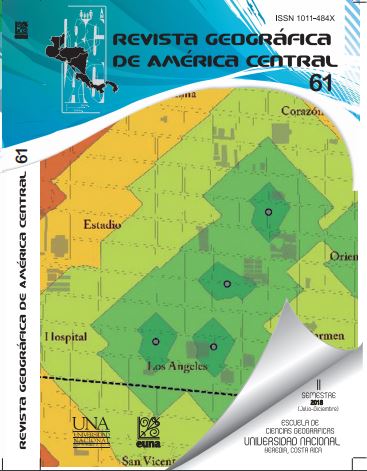The Effect of Soil Cover on Local Temperature Variations; Naranjo, Alajuela, Costa Rica, 2016
DOI:
https://doi.org/10.15359/rgac.61-2.7Keywords:
Landsat, soil cover, temperature.Abstract
The study aims to relate the variations in local temperatures in the central district of Naranjo, Alajuela, through the use of Landsat 8 images and Geographic Information Systems. A vectorization of the soil cover was carried out, and the areas of the different coverings were compared with the areas of the temperature ranges obtained, showing a relationship between high temperatures and urban areas and low temperatures and areas with vegetation. Showing the relationship between coverage and temperature is important to establish effective mitigation and adaptation measures in the face of climate changes and thus to avoid effects associated with urban areas such as the heat islands.
References
Ángel, L., Ramírez, A. & Domínguez, E. (2010). Isla de calor y cambios espacio-temporales de la temperatura en la ciudad de Bogotá. Rev. Acad. Colomb. Cienc., 34(131), 173-183
Casillas, A., García, R., Leyva, O. & González, F. (2014). Detección de la Isla Urbana de Calor mediante Modelado Dinámico en Mexicali, B.C., México. Información Tecnología, 25(1), 139-150
Congedo, L. (2016). Semi-Automatic Classification Plugin Documentation. Recuperado de https://media.readthedocs.org.
Environmental Protection Agency (EPA) (2009). Urban Heat Island Basics, Reducing Urban Heat Islands: Compendium of Strategies, Environmental Protection Agency, U.S. Recuperado de https://www.epa.gov.
ESRI. (2013). ArcGIS Desktop: Release 10.2. Redlands, CA: Environmental Systems Research Institute.
Foley, J., Heil, M., Delire, C., Ramankutty, N. & Snyder, P. (2003). Green surprise? How terrestrial ecosystems could affect earth’s climate. Front Ecol Environ, 2003 1(1), 38-44
Fundación Española para la Ciencia y la Tecnología (FECYT). (2004). Meteorología y Climatología: Semana de la Ciencia y la Tecnología 2004. Madrid, España: Universidad Nacional De Educación A Distancia FECYT.
Grimmond, S. (2007). Urbanization and Global Environmental Change: Local Effects of Urban Warming. Geographical Journal, 173(1), 83-88
Gutiérrez, R. (2011). Valor del Arbolado Urbano: La Experiencia de la Municipalidad de Santiago. Mundo Forestal 21, 4-7.
Martínez, T. (2015). Treinta años de Metamorfosis Urbana Territorial en el Valle Central. Informe final para: Vigesimoprimer Informe Estado de la Nación en Desarrollo Humano Sostenible (2014). Programa Estado de la Nación. Recuperado de http://www.estadonacion.or.cr.
Mirza, M. (2003). Climate Change and Extreme Weather Events: Can Developing Countries Adapt? Climate Policy, 3, 233-248
Municipalidad de Naranjo. (2012). Acta de la Sesión Extraordinaria Nº 02 del 21 de marzo del 2012. (Actas de la sesión). Recuperado de http://www.naranjo.go.cr.
Ochoa, J. (1999). La Vegetación como Instrumento para el Control Microclimático. (Tesis inédita de doctorado). Unviersitat Politècnica de Catalunya, Barcelona, España.
QGIS Development Team. (2016). QGIS Geographic Information System. Open Source Geospatial Foundation Project.
Rodríguez, N., Pabón, J., Bernal, N. & Martínez, J. (2010). Cambio climático y su relación con el uso del suelo en los Andes colombianos. Bogotá, Colombia: Instituto de Investigación de Recursos Biológicos Alexander von Humboldt, Universidad Nacional de Colombia y Departamento Administrativo de Ciencia, Tecnología e Innovación.
Romero, H., Irarrázaval, F., Opazo, D., Salgado, M. & Smith, P. (2010). Climas Urbanos y Contaminación Atmosférica en Santiago de Chile. EURE, 36(109), 35-62
Sarricolea, P., Aliste, E., Castro, P. & Escobedo, C. (2008). Análisis de la Máxima Intensidad de la Isla de Calor Urbana Nocturna de la Ciudad de Rancagua (Chile) y sus Factores Explicativos. Revista de Climatología, 8, 71-84
United Nations (2009). World Urbanization Prospects: The 2009 revision. Recuperado de http://ipcc-wg2.gov.
USGS. (2016). United States Geological Survey. Recuperado de https://www.usgs.gov.
Valor, E., Caselles, V., Coll, C., Sánchez, F., Rubio, E., & Sospedra, F. (2000). Análisis Comparativo del Efecto de Isla Térmica de la Ciudad de Valencia con Imágenes TM, MUST y AVHRR. Revista de Teledetección, (14), 1-6
Li X, Chen H, Liao H, Hua W, Sun S, Ma H, Li X, Gao C, Zhu S (2017) Potential effects of land cover change on temperature extremes over Eurasia: current versus historical experiments. Int. J. Climatol, 37(1), 59-74
Downloads
Published
How to Cite
Issue
Section
License
Proposed policy for journals offering Open Access
Authors publishing their works in the Journal acknowledge and agree to the following terms:
a) Authors retain the copyrights to their works and guarantee the Journal the right to be the first to publish their works, under the Creative Commons License Attribution-NonCommercial-ShareAlike 4.0 International, CC BY-NC-SA 4.0 International (https://creativecommons.org/licenses/by-nc-sa/4.0/deed.es), which allows others to share works upon complying with the acknowledgment of authorship and mention of the Journal as the original publisher of the work.
b) Authors are permitted to separately establish additional agreements for the non-exclusive distribution of the official edition of the work published in the Journal (for example, authors may desire to place the work in an institutional repository or incorporate it into a book that is to published elsewhere) so long they acknowledgment to recognize the Journal as the original publisher. The aforementioned additional agreements must respect the terms of the non-profit character and sharing philosophy of the original license (CC BY-NC-SA 4.0 International, https://creativecommons.org/licenses/by-nc-sa/4.0/deed.es).
c) Authors are encouraged to archive the post-print or editor/PDF version in Open Access repositories.






 REVGEO is licensed under https://creativecommons.org/licenses/by-nc-sa/4.0/deed.es
REVGEO is licensed under https://creativecommons.org/licenses/by-nc-sa/4.0/deed.es
.svg_4.png)

_(1).png)
_(1)_(1)_(1)_1.png)
(2)(1)(1)(1).png)
